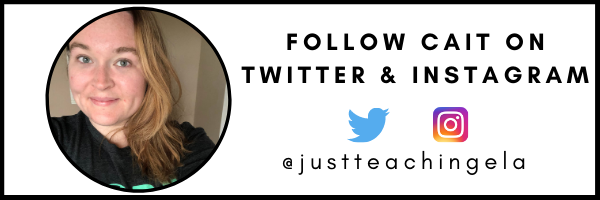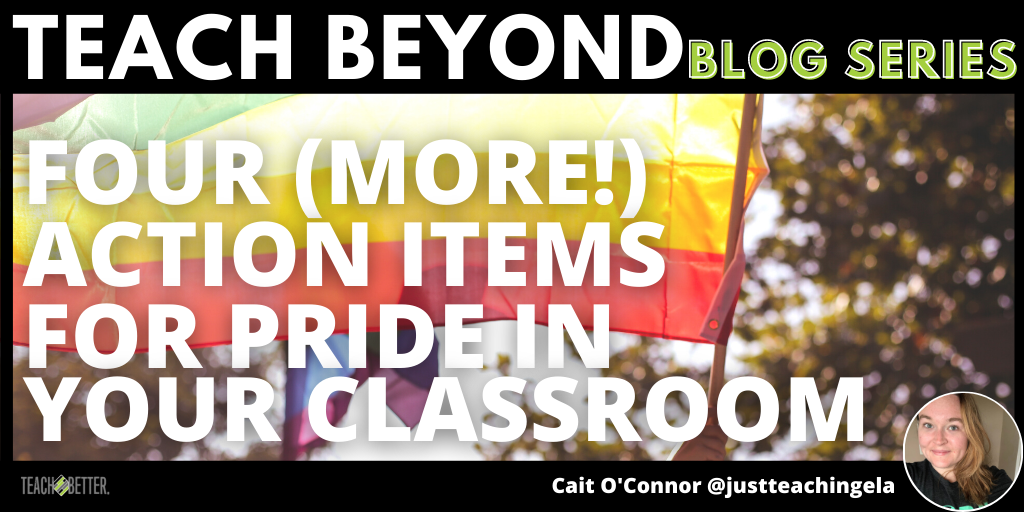TL;DR:
- This post is a follow-up to the post: Three Action Items for Pride Month in Your Classroom (and Beyond!)
- Four additional action items for Pride in your classroom include following representative leadership, amplifying others’ voices, making concrete commitments, and celebrating joy.
The response to this month’s post, “Three Action Items for Pride Month in Your Classroom (and Beyond!)” has been so positive! I am so grateful to the teachers everywhere taking action steps to make their schools and spaces safer and more celebratory of LGBTQIA+ people.
I thought it would be helpful to discuss more action items you can take during Pride month and beyond. This work matters a great deal to the LGBTQIA+ teachers and students who it is for. The ongoing commitment of educators is necessary to sustain safe spaces for us all.
Follow Representative Leadership (and honor their labor!)
Online or in person, Pride events should be led and organized by LGBTQIA+ people. Allyship is a wonderful and necessary element in encouraging and sustaining equality for all. But it’s important that the voices are heard of those who are in the community. The ones who benefit from the inclusion, or who experience the pain of exclusion if and when it happens, must be at the front of the room, speaking on what they need.
Research also suggests that reading makes people more empathetic. Valuing empathy and understanding others’ experiences and perspectives, even those you don’t align with or live through, is beneficial to everyone. Click To TweetDifferent People, Different Answers
The best thing you can do is ask LGBTQIA+ people what they need, and if or how you can help. Sometimes, the response you get will be, “We’ve got it from here, but thank you.” And that’s okay. From this point, you can use your platform, voice, and space to amplify, repost, retweet, spread the word, and compensate those already in the work.
It’s important to understand and know that LGBTQIA+ people are not a monolith. Different people prefer different language and are at different places and spaces in their journey. This is true for anyone! Some examples may include the language between preferred pronouns, social/physical transition logistics, or being out in some spaces and not others.
When in doubt, talk to the people who are members of the LGBTQIA+ community and follow their lead. It’s tempting to say, “I can’t keep up, I quit!” when you don’t 100 percent get it right. But that is the essence of commitment to representation, equality, and inclusivity. Everyone is different. Follow the lead of those representing and identifying as LGBTQIA+ in your space, always. Recognize their labor and contributions with appropriate compensation.
How to Amplify Effectively
One important question is: “How do I bring this up to my institution so that it can be changed?” This is a great start! The most important thing to consider when wanting to make changes that are more LGBTQIA+ inclusive in your school and in your community are these questions:
1) Has change already been initiated by someone who needs those changes in order to feel safe?
2) Is their experience being accounted for/are their demands or needs being heard by those in power? Are the needs of those with different marginalities (BIPOC, disabled folks, noncitizen folks, and more) being heard/seen by those in power?
3) Have I asked this person if/how I can help? Have I been given the green light to use my voice or amplify theirs?
These questions are important for discerning the difference between holding space and taking up space (another great Sam Killermann illustration for this one!). Holding space means amplifying the folks who benefit from the work of inciting change in our schools and communities. Taking up space can be a way to use one’s privilege, too. But we must be mindful of the ways that our voices may overpower those who need the work of justice, equity, inclusion, and safety the most.
Make Concrete Commitments
One of the action items from my initial post was to challenge and change policy. Institutional, administrative and community commitments to LGBTQIA+ students and faculty must be concrete, specific and meaningful. How do we shift from “all are welcome” to “here’s how we welcome all people here”?
- State exactly what your institution is doing to better the lives of LGBTQIA+ students and staff members. An example: “Our school encourages all students to participate in activities in a way that upholds and affirms their identity without feeling endangered. We are creating co-ed sports teams for all students to enroll and participate in beginning this fall.”
- State what your institution is doing to challenge policies and systems that exclude or harm LGBTQIA+ people. An example: “Our school is working to acknowledge the right that students have to utilize the correct names and pronouns that affirm their identity. We recognize that there are legal documentation barriers that deny students this right, but while we resolve this issue, here are tools we have available to students who identify with names and pronouns that differ from their legal documentation.”
More Language Tips
How affirming and inclusive policy is written can mean the difference between performative and actionable allyship.
For instance, avoid words like ‘chosen name’ or ‘preferred pronouns’. As I mentioned previously, different people use different terms and referents when self-identifying under the LGBTQIA+ umbrella. But the way we frame and position these words when referring to a community of people matters. ‘Chosen name‘ implies that a person can change the fact that they are trans/gender nonconforming/nonbinary; and thus, that their transition into a more affirming identity is a choice they can be dissuaded from. The connotation of choice lays the burden of being different on the person who is not subscribed to heteronormative and cissexist conventions of our society. They may have picked a new name to represent their truest self, but it is just that—their name.
[scroll down to keep reading]
Validate & Celebrate Joy
Many narratives including LGBTQIA+ experience reflect a history of difference and otherness. It’s important to take time to celebrate the joy and accomplishment of LGBTQIA+ people. Learning about the adversity and historical struggle of the LGBTQIA+ community matters. Teaching stories like The Laramie Project and other narratives that illuminate homophobia and the danger of hate, matters.
However, it is not the whole story of the LGBTQIA+ community. We have experienced joy, triumph, love, family, and empowerment. Stories that highlight the success we have had at work, at school, in relationships, and with ourselves can and do show the youth and future generations that it is unconditionally okay to be you.
K-5 books like And Tango Makes Three, Julien is a Mermaid, and I am Jazz can send these messages to students in our classrooms. For young adults, books like Juliet Takes a Breath, The Prince and the Dressmaker, None of the Above, The Black Flamingo, Felix Ever After and All Boys Aren’t Blue can do the same.
If you’re worried about bringing LGBTQIA+ affirming literature into your classroom, NCTE has some great resources on students’ right to read. Research also suggests that reading makes people more empathetic. Valuing empathy and understanding others’ experiences and perspectives, even those you don’t align with or live through, is beneficial to everyone.
About Cait O’Connor
Cait O’Connor is a fourth-year public school English/ESOL educator in New York, committed to social justice and equity in education and beyond.


